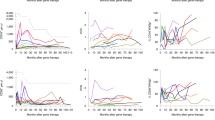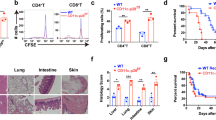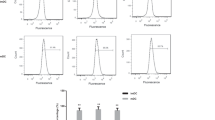Abstract
Wiskott–Aldrich syndrome (WAS) is a rare X-linked primary immunodeficiency caused by the defective expression of the WAS protein (WASP) in hematopoietic cells. It has been shown that dendritic cells (DCs) are functionally impaired in WAS patients and was−/− mice. We have previously demonstrated the efficacy and safety of a murine model of WAS gene therapy (GT), using stem cells transduced with a lentiviral vector (LV). The aim of this study was to investigate whether GT can correct DC defects in was−/− mice. As DCs expressing WASP were detected in the secondary lymphoid organs of the treated mice, we tested the in vitro and in vivo function of bone marrow-derived DCs (BMDCs). The BMDCs showed efficient in vitro uptake of latex beads and Salmonella typhimurium. When BMDCs from the treated mice (GT BMDCs) and the was−/− mice were injected into wild-type hosts, we found a higher number of cells that had migrated to the draining lymph nodes compared with mice injected with was−/− BMDCs. Finally, we found that ovalbumin (OVA)-pulsed GT BMDCs or vaccination of GT mice with anti-DEC205 OVA fusion protein can efficiently induce antigen-specific T-cell activation in vivo. These findings show that WAS GT significantly improves DC function, thus adding new evidence of the preclinical efficacy of LV-mediated WAS GT.
This is a preview of subscription content, access via your institution
Access options
Subscribe to this journal
Receive 12 print issues and online access
$259.00 per year
only $21.58 per issue
Buy this article
- Purchase on Springer Link
- Instant access to full article PDF
Prices may be subject to local taxes which are calculated during checkout






Similar content being viewed by others
References
Bosticardo M, Marangoni F, Aiuti A, Villa A, Roncarolo MG . Recent advances in understanding the pathophysiology of Wiskott-Aldrich syndrome. Blood 2009; 113: 6288–6295.
Thrasher AJ, Burns SO . WASP: a key immunological multitasker. Nat Rev 2010; 10: 182–192.
Dupre L, Aiuti A, Trifari S, Martino S, Saracco P, Bordignon C et al. Wiskott-Aldrich syndrome protein regulates lipid raft dynamics during immunological synapse formation. Immunity 2002; 17: 157–166.
Trifari S, Sitia G, Aiuti A, Scaramuzza S, Marangoni F, Guidotti LG et al. Defective Th1 cytokine gene transcription in CD4+ and CD8+ T cells from Wiskott-Aldrich syndrome patients. J Immunol 2006; 177: 7451–7461.
Nikolov NP, Shimizu M, Cleland S, Bailey D, Aoki J, Strom T et al. Systemic autoimmunity and defective Fas ligand secretion in the absence of the Wiskott-Aldrich syndrome protein. Blood 2010; 116: 740–747.
De Meester J, Calvez R, Valitutti S, Dupre L . The Wiskott-Aldrich syndrome protein regulates CTL cytotoxicity and is required for efficient killing of B cell lymphoma targets. J Leuk Biol 2010; 88: 1031–1040.
Orange JS, Ramesh N, Remold-O’Donnell E, Sasahara Y, Koopman L, Byrne M et al. Wiskott-Aldrich syndrome protein is required for NK cell cytotoxicity and colocalizes with actin to NK cell-activating immunologic synapses. Proc Nat Acad Sci USA 2002; 99: 11351–11356.
Adriani M, Aoki J, Horai R, Thornton AM, Konno A, Kirby M et al. Impaired in vitro regulatory T cell function associated with Wiskott-Aldrich syndrome. Clin Immunol (Orlando, FL) 2007; 124: 41–48.
Humblet-Baron S, Sather B, Anover S, Becker-Herman S, Kasprowicz DJ, Khim S et al. Wiskott-Aldrich syndrome protein is required for regulatory T cell homeostasis. J Clin Invest 2007; 117: 407–418.
Maillard MH, Cotta-de-Almeida V, Takeshima F, Nguyen DD, Michetti P, Nagler C et al. The Wiskott-Aldrich syndrome protein is required for the function of CD4(+)CD25(+)Foxp3(+) regulatory T cells. J Exp Med 2007; 204: 381–391.
Marangoni F, Trifari S, Scaramuzza S, Panaroni C, Martino S, Notarangelo LD et al. WASP regulates suppressor activity of human and murine CD4(+)CD25(+)FOXP3(+) natural regulatory T cells. J Exp Med 2007; 204: 369–380.
Westerberg L, Larsson M, Hardy SJ, Fernandez C, Thrasher AJ, Severinson E . Wiskott-Aldrich syndrome protein deficiency leads to reduced B-cell adhesion, migration, and homing, and a delayed humoral immune response. Blood 2005; 105: 1144–1152.
Meyer-Bahlburg A, Becker-Herman S, Humblet-Baron S, Khim S, Weber M, Bouma G et al. Wiskott-Aldrich syndrome protein deficiency in B cells results in impaired peripheral homeostasis. Blood 2008; 112: 4158–4169.
Burns S, Thrasher AJ, Blundell MP, Machesky L, Jones GE . Configuration of human dendritic cell cytoskeleton by Rho GTPases, the WAS protein, and differentiation. Blood 2001; 98: 1142–1149.
Calle Y, Chou HC, Thrasher AJ, Jones GE . Wiskott-Aldrich syndrome protein and the cytoskeletal dynamics of dendritic cells. J Pathol 2004; 204: 460–469.
Binks M, Jones GE, Brickell PM, Kinnon C, Katz DR, Thrasher AJ . Intrinsic dendritic cell abnormalities in Wiskott-Aldrich syndrome. Eur J Immunol 1998; 28: 3259–3267.
de Noronha S, Hardy S, Sinclair J, Blundell MP, Strid J, Schulz O et al. Impaired dendritic-cell homing in vivo in the absence of Wiskott-Aldrich syndrome protein. Blood 2005; 105: 1590–1597.
Bouma G, Burns S, Thrasher AJ . Impaired T-cell priming in vivo resulting from dysfunction of WASp-deficient dendritic cells. Blood 2007; 110: 4278–4284.
Pulecio J, Tagliani E, Scholer A, Prete F, Fetler L, Burrone OR et al. Expression of Wiskott-Aldrich syndrome protein in dendritic cells regulates synapse formation and activation of naive CD8+ T cells. J Immunol 2008; 181: 1135–1142.
Bouma G, Mendoza-Naranjo A, Blundell MP, de Falco E, Parsley KL, Burns SO et al. Cytoskeletal remodeling mediated by WASp in dendritic cells is necessary for normal immune synapse formation and T-cell priming. Blood 2011; 118: 2492–2501.
Linder S, Nelson D, Weiss M, Aepfelbacher M . Wiskott-Aldrich syndrome protein regulates podosomes in primary human macrophages. Proc Nat Acad Sci USA 1999; 96: 9648–9653.
Tsuboi S, Meerloo J . Wiskott-Aldrich syndrome protein is a key regulator of the phagocytic cup formation in macrophages. J Biol Chem 2007; 282: 34194–34203.
Astrakhan A, Ochs HD, Rawlings DJ . Wiskott-Aldrich syndrome protein is required for homeostasis and function of invariant NKT cells. J Immunol 2009; 182: 7370–7380.
Locci M, Draghici E, Marangoni F, Bosticardo M, Catucci M, Aiuti A et al. The Wiskott-Aldrich syndrome protein is required for iNKT cell maturation and function. J Exp Med 2009; 206: 735–742.
Zhang H, Schaff UY, Green CE, Chen H, Sarantos MR, Hu Y et al. Impaired integrin-dependent function in Wiskott-Aldrich syndrome protein-deficient murine and human neutrophils. Immunity 2006; 25: 285–295.
Cianferoni A, Massaad M, Feske S, de la Fuente MA, Gallego L, Ramesh N et al. Defective nuclear translocation of nuclear factor of activated T cells and extracellular signal-regulated kinase underlies deficient IL-2 gene expression in Wiskott-Aldrich syndrome. J Allergy Clin Immunol 2005; 116: 1364–1371.
Antoine C, Muller S, Cant A, Cavazzana-Calvo M, Veys P, Vossen J et al. Long-term survival and transplantation of haemopoietic stem cells for immunodeficiencies: report of the European experience 1968-99. Lancet 2003; 361: 553–560.
Imai K, Morio T, Zhu Y, Jin Y, Itoh S, Kajiwara M et al. Clinical course of patients with WASP gene mutations. Blood 2004; 103: 456–464.
Filipovich AH, Stone JV, Tomany SC, Ireland M, Kollman C, Pelz CJ et al. Impact of donor type on outcome of bone marrow transplantation for Wiskott-Aldrich syndrome: collaborative study of the International Bone Marrow Transplant Registry and the National Marrow Donor Program. Blood 2001; 97: 1598–1603.
Kobayashi R, Ariga T, Nonoyama S, Kanegane H, Tsuchiya S, Morio T et al. Outcome in patients with Wiskott-Aldrich syndrome following stem cell transplantation: an analysis of 57 patients in Japan. Br J Haematol 2006; 135: 362–366.
Pai SY, DeMartiis D, Forino C, Cavagnini S, Lanfranchi A, Giliani S et al. Stem cell transplantation for the Wiskott-Aldrich syndrome: a single-center experience confirms efficacy of matched unrelated donor transplantation. Bone Marrow Transplant 2006; 38: 671–679.
Ozsahin H, Cavazzana-Calvo M, Notarangelo LD, Schulz A, Thrasher AJ, Mazzolari E et al. Long-term outcome following hematopoietic stem-cell transplantation in Wiskott-Aldrich syndrome: collaborative study of the European Society for Immunodeficiencies and European Group for Blood and Marrow Transplantation. Blood 2008; 111: 439–445.
Friedrich W, Schutz C, Schulz A, Benninghoff U, Honig M . Results and long-term outcome in 39 patients with Wiskott-Aldrich syndrome transplanted from HLA-matched and -mismatched donors. Immunol Res 2009; 44: 18–24.
Dupre L, Marangoni F, Scaramuzza S, Trifari S, Hernandez RJ, Aiuti A et al. Efficacy of gene therapy for Wiskott-Aldrich syndrome using a WAS promoter/cDNA-containing lentiviral vector and nonlethal irradiation. Hum Gene Ther 2006; 17: 303–313.
Marangoni F, Bosticardo M, Charrier S, Draghici E, Locci M, Scaramuzza S et al. Evidence for long-term efficacy and safety of gene therapy for Wiskott-Aldrich syndrome in preclinical models. Mol Ther 2009; 17: 1073–1082.
Charrier S, Stockholm D, Seye K, Opolon P, Taveau M, Gross DA et al. A lentiviral vector encoding the human Wiskott-Aldrich syndrome protein corrects immune and cytoskeletal defects in WASP knockout mice. Gene Therapy 2005; 12: 597–606.
Charrier S, Dupre L, Scaramuzza S, Jeanson-Leh L, Blundell MP, Danos O et al. Lentiviral vectors targeting WASp expression to hematopoietic cells, efficiently transduce and correct cells from WAS patients. Gene Therapy 2007; 14: 415–428.
Blundell MP, Bouma G, Calle Y, Jones GE, Kinnon C, Thrasher AJ . Improvement of migratory defects in a murine model of Wiskott-Aldrich syndrome gene therapy. Mol Ther 2008; 16: 836–844.
Boztug K, Schmidt M, Schwarzer A, Banerjee PP, Diez IA, Dewey RA et al. Stem-cell gene therapy for the Wiskott-Aldrich syndrome. N Engl J Med 2010; 363: 1918–1927.
Coquerelle C, Moser M . DC subsets in positive and negative regulation of immunity. Immunol Rev 2010; 234: 317–334.
Degli-Esposti MA, Smyth MJ . Close encounters of different kinds: dendritic cells and NK cells take centre stage. Nat Rev 2005; 5: 112–124.
Lorenzi R, Brickell PM, Katz DR, Kinnon C, Thrasher AJ . Wiskott-Aldrich syndrome protein is necessary for efficient IgG-mediated phagocytosis. Blood 2000; 95: 2943–2946.
Leverrier Y, Lorenzi R, Blundell MP, Brickell P, Kinnon C, Ridley AJ et al. Cutting edge: the Wiskott-Aldrich syndrome protein is required for efficient phagocytosis of apoptotic cells. J Immunol 2001; 166: 4831–4834.
Westerberg L, Wallin RP, Greicius G, Ljunggren HG, Severinson E . Efficient antigen presentation of soluble, but not particulate, antigen in the absence of Wiskott-Aldrich syndrome protein. Immunology 2003; 109: 384–391.
Calle Y, Anton IM, Thrasher AJ, Jones GE . WASP and WIP regulate podosomes in migrating leukocytes. J Microsc 2008; 231: 494–505.
Monypenny J, Chou HC, Banon-Rodriguez I, Thrasher AJ, Anton IM, Jones GE et al. Role of WASP in cell polarity and podosome dynamics of myeloid cells. Eur J Cell Biol 2010; 90: 198–204.
Calle Y, Burns S, Thrasher AJ, Jones GE . The leukocyte podosome. Eur J Cell Biol 2006; 85: 151–157.
Nchinda G, Kuroiwa J, Oks M, Trumpfheller C, Park CG, Huang Y et al. The efficacy of DNA vaccination is enhanced in mice by targeting the encoded protein to dendritic cells. J Clin Invest 2008; 118: 1427–1436.
Tagliani E, Guermonprez P, Sepulveda J, Lopez-Bravo M, Ardavin C, Amigorena S et al. Selection of an antibody library identifies a pathway to induce immunity by targeting CD36 on steady-state CD8 alpha+ dendritic cells. J Immunol 2008; 180: 3201–3209.
Bonifaz LC, Bonnyay DP, Charalambous A, Darguste DI, Fujii S, Soares H et al. In vivo targeting of antigens to maturing dendritic cells via the DEC-205 receptor improves T cell vaccination. J Exp Med 2004; 199: 815–824.
Allenspach EJ, Lemos MP, Porrett PM, Turka LA, Laufer TM . Migratory and lymphoid-resident dendritic cells cooperate to efficiently prime naive CD4 T cells. Immunity 2008; 29: 795–806.
Wu L, Shortman K . Heterogeneity of thymic dendritic cells. Semin Immunol 2005; 17: 304–312.
Klein C, Nguyen D, Liu CH, Mizoguchi A, Bhan AK, Miki H et al. Gene therapy for Wiskott-Aldrich syndrome: rescue of T-cell signaling and amelioration of colitis upon transplantation of retrovirally transduced hematopoietic stem cells in mice. Blood 2003; 101: 2159–2166.
Zhang J, Shehabeldin A, da Cruz LA, Butler J, Somani AK, McGavin M et al. Antigen receptor-induced activation and cytoskeletal rearrangement are impaired in Wiskott-Aldrich syndrome protein-deficient lymphocytes. J Exp Med 1999; 190: 1329–1342.
Petrella A, Doti I, Agosti V, Giarrusso PC, Vitale D, Bond HM et al. A 5′ regulatory sequence containing two Ets motifs controls the expression of the Wiskott-Aldrich syndrome protein (WASP) gene in human hematopoietic cells. Blood 1998; 91: 4554–4560.
Dupre L, Trifari S, Follenzi A, Marangoni F, Lain de Lera T, Bernad A et al. Lentiviral vector-mediated gene transfer in T cells from Wiskott-Aldrich syndrome patients leads to functional correction. Mol Ther 2004; 10: 903–915.
Li E, Pedraza A, Bestagno M, Mancardi S, Sanchez R, Burrone O . Mammalian cell expression of dimeric small immune proteins (SIP). Protein Eng 1997; 10: 731–736.
Acknowledgements
This work was supported by grants from Italian Telethon Foundation to AV, Telethon Grant GGP06267 to FB, and Ministero della Salute RF 2007-2008 Giovani Ricercatori Grant (to MB).
Author information
Authors and Affiliations
Corresponding author
Ethics declarations
Competing interests
The authors declare no conflict of interest.
Additional information
Supplementary Information accompanies the paper on Gene Therapy website
Supplementary information
Rights and permissions
About this article
Cite this article
Catucci, M., Prete, F., Bosticardo, M. et al. Dendritic cell functional improvement in a preclinical model of lentiviral-mediated gene therapy for Wiskott–Aldrich syndrome. Gene Ther 19, 1150–1158 (2012). https://doi.org/10.1038/gt.2011.202
Received:
Revised:
Accepted:
Published:
Issue Date:
DOI: https://doi.org/10.1038/gt.2011.202
Keywords
This article is cited by
-
Gene transfer into hematopoietic stem cells as treatment for primary immunodeficiency diseases
International Journal of Hematology (2014)



